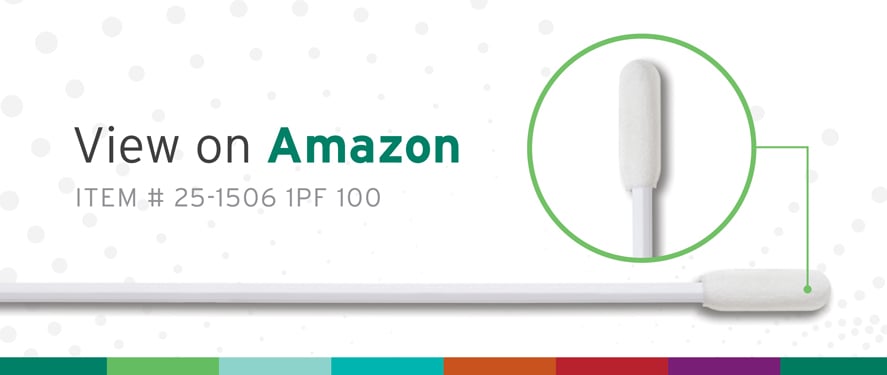
Are you administering a flu or COVID-19 test?
Your patients may be wondering what the difference between a nasal swab test and a nasopharyngeal test is. In this article, we explain the core difference between these two tests, as well as the swabs used to collect them.
What is a Nasal Swab?
A nasal swab is a type of medical product that healthcare practitioners and individuals can use to test for common respiratory conditions and illnesses like COVID-19. These swabs typically have a medium-sized tip that is made from an absorbent material, usually flocked fibers, spun polyester, or medical-grade foam. The handle of a nasal swab used for this diagnostic testing is usually made of polystyrene.
Nasal swabs are often found in home testing kits but are also commonly used in doctor’s offices or medical facilities for a variety of nasal swabbing needs. They’re considered safe enough for patients to use since they’re only meant to be inserted into the nostril 0.5 to 0.75 inches. They’re slightly flexible to allow for ease of use but are rigid enough to make collecting a sample from the nasal cavity easy and effective.
But they are slightly different from their cousin, the nasopharyngeal swab…here’s how.
What is a Nasopharyngeal Swab?
A nasopharyngeal swab is designed for use in medical facilities like hospitals, clinics, and mobile care units. These swabs are designed with a miniature tip made of an ultrafine flocked material and have a thin, flexible handle usually made of polystyrene.
The handles on nasopharyngeal swabs are typically more flexible than those found on nasal swabs to improve comfort for patients during tests since they’re designed to reach the nasopharynx behind the nose.
What is the Nasal Swab Method?
The nasal swab method is done with a swab to collect a diagnostic sample from the nasal membrane. The nasal swab test – commonly referred to as an anterior nasal test– involves inserting a swab into the nostril about 0.5-.75 inches deep, and while touching the sides of the nasal wall is rotated for 10-15 seconds in one nostril, then with the same swab, collected the same way in the other nostril. Because this method is less invasive, it is usually more comfortable for the patient—and also the method used when self-testing.
Check out the CDC-recommended guidelines for COVID-19 nasal swab testing.
What is the Nasopharyngeal Swabbing Method?
The nasopharyngeal collection method collects a sample from the nasopharynx, which is the upper part of the throat behind the nose. For this test, a small, mini-tipped swab is inserted into the nostril parallel to the chin, until resistance is felt. The swab is inserted no deeper than half the distance between the nostrils and the ear. The swab will then be rotated a few times while holding in place, then slowly removed while gently rotating. If the tip of the swab is fully saturated with specimens, it may not be necessary to collect a sample from both nostrils.
This method tends to be less comfortable for the patient but is not usually considered painful. This method is not recommended for self-testing and should only be performed by a healthcare practitioner.
These swabs feature tapered handles for enhanced patient comfort and ease of use.
Nasal vs Nasopharyngeal Swabs for Seasonal Illness Testing
Both nasal swabs and nasopharyngeal swabs can detect common seasonal illnesses like the flu, COVID-19, strep, and RSV. However, most physicians prefer nasopharyngeal swabs as the specimens collected typically yield more accurate results when the test is administered in a clinic or by a trained medical professional. Nasopharyngeal swabs are not designed for use at home, making them a less versatile tool for the general public.
Nasal swabs, on the other hand, give both medical practitioners and the general public the ability to perform screenings themselves. They’re easier for patients to use at home, making them ideal for early detection of contagious viruses and mitigating exposure in crowded waiting rooms.
|
Seasonal Illnesses |
Type of Swab |
|
Strep throat |
Nasopharyngeal |
|
COVID-19 |
Nasal or nasopharyngeal |
|
RSV |
Nasopharyngeal |
|
Common cold |
Nasal or nasopharyngeal |
|
Influenza |
Nasal or Nasopharyngeal |
Many seasonal illnesses can be diagnosed by either swabbing method. However, it’s largely up to the medical practitioner to determine which swab will be best suited to each patient’s comfort and tolerance level.
Which Swab Test is More Accurate?
The nasopharyngeal swabbing is generally the preferred method of specimen collection for COVID-19 testing though it is typically less comfortable than nasal swabbing.
Researchers determined that nasopharyngeal swabs produced a 97% detection rate for RSV. Nasal swabs only yielded a 76% detection rate.
However, a 2012 comparison study showed no significant statistical difference between the two methods for flu testing.
Puritan takes great care to design swabs that prioritize efficient testing, assuring collection of an ample specimen an ample specimen while being mindful of patient comfort.
CDC recommends collecting and testing an upper respiratory specimen, such as nasopharyngeal, nasal mid-turbinate, or anterior nasal when using NAATs for confirmatory testing. In cases of discordant test results from different types of tests, results from laboratory-based NAATs should be prioritized over any POC or self-administered test. Source
The Best Nasal Swabs
There are several types of nasal swabs that can be used to test for upper respiratory viruses like COVID-19 and the flu. These are some of the best.
Puritan 6” Sterile Foam Swab w/Polystyrene Handle
The Puritan 6” Sterile Foam Swab (SKU#: 25-1506 1PF 100) is a nasal swab that features a regular foam-tipped applicator with a plastic handle that is six inches long and can be used for a variety of diagnostic tests ranging from DNA testing to COVID-19 screenings. The tip is sterile, ensuring a specimen free of extraneous contamination.. It’s also available packed in a dry transport system to securely protect samples for processing. The foam has a high particle collection capacity, making sufficient collection easier.
HydraFlock 6” Sterile Elongated Flock Swab w/Polystyrene Handle
The HydraFlock 6” Sterile Elongated Flock Swab (SKU#: 25-3206-H) features a tip made of multi-length fibers to rapidly absorb and release specimens. Each swab is individually wrapped to maintain sterility and can be used for rapid diagnostic testing.
Puritan 6” Sterile Standard Polyester Swab w/Polystyrene Handle
The Puritan 6” Sterile Standard Polyester Swab (SKU#: 25-806 1PD) is tipped with spun polyester fiber, ideal for specimen collection like throat swabbing or screening for COVID-19 and RSV. But the swab can also be used for other diagnostic screenings, including nasal screenings.
The Best Nasopharyngeal Swabs
Nasopharyngeal swabs are able to collect specimens that nasal swabs are not able to reach comfortably. Here are some of the best swabs Puritan offers.
Puritan 6” Sterile Mini-Tip Foam Swab w/Tapered Acetal Handle
The Puritan 6” Sterile Mini-Tip Foam Swab (SKU#: 25-1406) is a small foam tip that’s ideal for collecting nasopharyngeal specimens. The handle is thin and tapered, giving it better flexibility to further improve the patient experience.
HydraFlock 6" Sterile Ultrafine Flock Swab w/Polystyrene Handle
The HydraFlock 6" Sterile Ultrafine Flock Swab (SKU#: 25-3317-H) uses an ultrafine polyester flock tip that’s designed with rapid absorption and quick release of biological specimens in mind. It’s ideal for rapid diagnostic testing, but can also be used for nasopharyngeal collection.
Puritan 6" Sterile Mini-tip Polyester Swab w/Aluminum & Plastic Handle
The Puritan 6" Sterile Mini-tip Polyester Swab with Aluminum and Plastic Handle (SKU#: 25-800 1PD ALUM 50) uses a polyester mini-tip designed to reduce patient discomfort so screenings are easier. Each swab is individually wrapped to maintain sterility and make storing the swabs easy.
Stock Up on Testing Supplies
Puritan Medical Products’ nasal and nasopharyngeal swabs can be used for a wide variety of specimen collection, making it easy to stock up your testing kit with swabs that fit your needs. Whether you’re looking to build out comprehensive viral testing kits for your clinic, need to add swabs to DNA testing kits, or are developing home testing kits to help families monitor their health from the comfort of their own homes, our team is here to help.
Contact us to speak with our knowledgeable product specialists.






